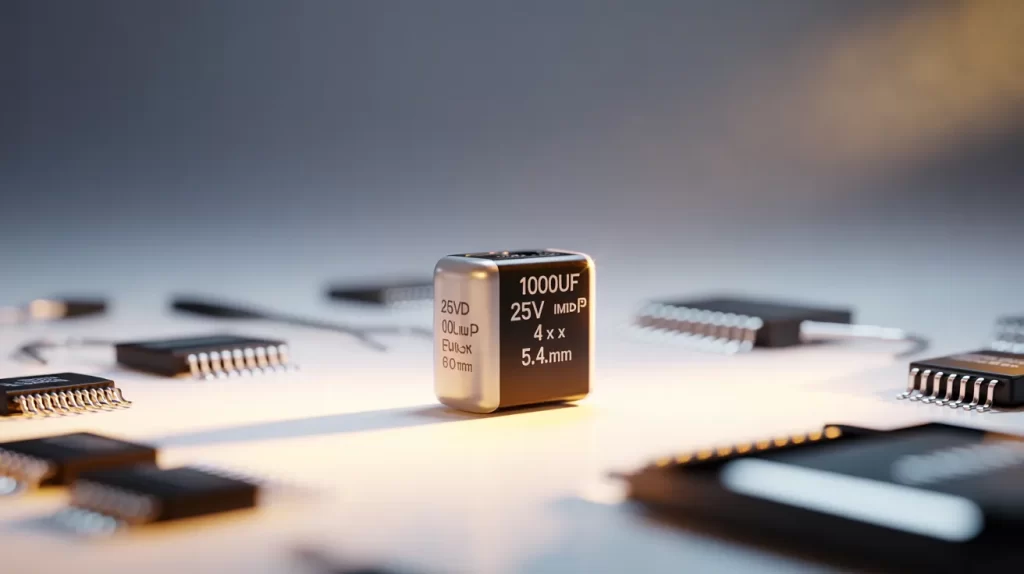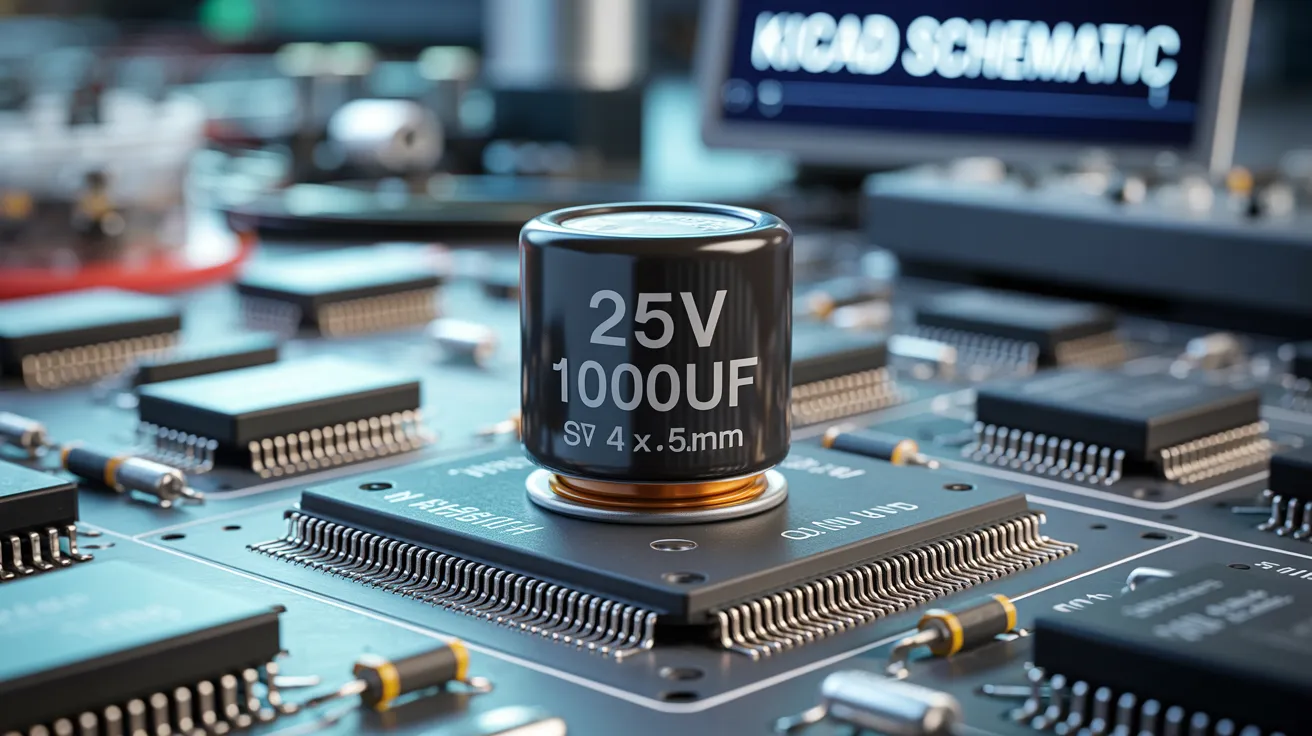Table of Contents
When designing circuits in KiCad, it is essential to have access to high-quality components that will ensure your project functions seamlessly.
One such vital component is the 25V 1000uF SMD (Surface-Mounted Device) 4 x 5.4mm Electrolytic Capacitor.
In this guide, we will explore its significance in circuit design, how to integrate it into your KiCad designs, and provide a comprehensive understanding of its features and applications.
Whether you’re a seasoned engineer or a beginner in electronics design, this guide will equip you with the knowledge needed to optimize your use of this critical component.
What is a 25V 1000uF SMD 4 x 5.4mm Electrolytic Capacitor KiCad?
A 25V 1000uF SMD Electrolytic Capacitor is a specific type of capacitor used primarily for energy storage and filtering in electronic circuits.
Its 25V rating indicates the maximum voltage the capacitor can handle without breaking down, and the 1000uF denotes its capacitance, which is the ability to store charge.
The SMD (Surface-Mounted Device) type allows for a more compact design, which is especially beneficial in modern circuit boards where space is limited.
Key Features of the 25V 1000uF SMD Electrolytic Capacitor
- Capacitance: 1000uF, ideal for applications requiring substantial energy storage.
- Voltage Rating: With a 25V rating, it provides adequate voltage tolerance for most common circuits.
- Size: The 4 x 5.4mm footprint ensures compatibility with compact PCB designs.
- Polarized: It has polarity, meaning correct orientation must be maintained during placement on the PCB.
Applications of 25V 1000uF Electrolytic Capacitors in Circuits

These capacitors are commonly used in various applications due to their high capacitance and voltage rating. Here are a few ways they play a vital role in circuit design:
Power Supply Filtering
Capacitors with high capacitance, like the 25V 1000uF, are ideal for power supply filtering. They smooth out voltage fluctuations and prevent noise in the power supply, ensuring that other components receive a stable voltage.
Energy Storage in Pulse Circuits
In pulse circuits, where quick energy discharge is necessary, the 1000uF capacitance can store and release energy quickly. This is crucial for applications like flash photography, radar systems, and even certain motor drives.
Decoupling and Bypass Capacitors
In digital circuits, capacitors like the 25V 1000uF are used as decoupling capacitors to eliminate power supply noise, improving the signal integrity of sensitive circuits like microcontrollers and processors.
Motor Drives
In motor drive circuits, these capacitors help in reducing ripple currents and provide smooth power flow, improving motor performance and efficiency.
Read also: 127.0.0.1:62893
How to Use the 25V 1000uF SMD Electrolytic Capacitor in KiCad?
Integrating a 25V 1000uF SMD Electrolytic Capacitor into a KiCad schematic is an essential skill for circuit designers. Below is a detailed guide to help you incorporate this component efficiently:
Add the Component to Your KiCad Library
- Open KiCad and navigate to your schematic layout.
- Use the “Add Components” tool, and in the search bar, type “Electrolytic Capacitor” to find a matching component. If one is not available, you can add a custom component by creating a symbol for the 25V 1000uF SMD capacitor.
- Once located or created, place the component onto your schematic.
Set the Component Parameters
- Set the capacitance value to 1000uF.
- Set the voltage rating to 25V to match your component specifications.
- Define the footprint as SMD 4×5.4mm, ensuring it aligns with the physical size of your chosen capacitor.
Position the Component
Place the capacitor in the appropriate section of your circuit. Typically, electrolytic capacitors are placed in the power supply section, across the positive and negative rails, or in parallel to stabilize the power.
Electrical Connections
Connect the positive and negative terminals of the capacitor to the power and ground planes. Remember that electrolytic capacitors are polarized, so the positive terminal must be connected to the higher voltage (positive side), and the negative terminal to the ground (or lower voltage side).
Why Choose SMD for Electrolytic Capacitors?
The SMD (Surface-Mounted Device) version of the 25V 1000uF electrolytic capacitor is highly advantageous for modern electronic designs, especially in compact and high-density PCB layouts. Below are the reasons why SMD versions are often preferred:
Space Efficiency
SMD capacitors occupy less physical space on the PCB, which is crucial for compact designs where board area is limited.
Easier to Automate Production
SMD components are easier to handle and place using automated surface-mount technology (SMT) machines, improving manufacturing speed and consistency.
Better Electrical Performance
SMD capacitors generally offer lower inductance and resistance than through-hole components, providing better performance at high frequencies.
Factors to Consider When Selecting Electrolytic Capacitors for Your Circuit
When selecting a 25V 1000uF electrolytic capacitor or any other component for your circuit design, several factors should be considered to ensure optimal performance:
Voltage Rating
The voltage rating of the capacitor must exceed the maximum voltage in the circuit to avoid breakdown and failure. The 25V rating is suitable for most low to medium voltage circuits, but always verify the specific requirements of your project.
Capacitance
Capacitance determines how much charge the capacitor can store. A 1000uF capacitor is ideal for applications requiring substantial filtering or energy storage. Choose a capacitor with appropriate capacitance for your needs.
Temperature Range
The operating temperature range of the capacitor is another essential factor. Ensure that the capacitor’s operating temperature range suits the environment in which the circuit will function.
ESR (Equivalent Series Resistance)
Low ESR is important for high-frequency applications. Ensure that the ESR is within the acceptable limits to prevent overheating and ensure smooth operation of your circuit.
Final Words
The 25V 1000uF SMD Electrolytic Capacitor is a versatile and essential component in many electronic designs.
Whether you’re working on power supply filters, pulse circuits, or motor drives, this component can help optimize your circuit’s performance.
By following the steps for integration in KiCad and understanding the factors that influence capacitor performance, you can maximize the potential of this crucial component in your designs.
People also ask
What is the use of a 25V 1000uF SMD electrolytic capacitor?
It is used for power supply filtering, energy storage, and decoupling in electronic circuits, ensuring stable voltage and reducing noise.
Can I use a 25V 1000uF capacitor in high-voltage circuits?
No, it is rated for 25V. Using it in circuits with voltages higher than this could damage the capacitor and your circuit.
What is the difference between SMD and through-hole capacitors?
SMD capacitors are smaller, have better electrical performance, and are easier to automate in manufacturing, while through-hole capacitors are larger and require manual placement.
How do I correctly place a polarized electrolytic capacitor?
Ensure the positive terminal connects to the higher voltage side and the negative terminal to the ground or lower voltage side.
Can I replace a 25V 1000uF capacitor with one of a different voltage?
You can, but ensure the replacement capacitor’s voltage rating is at least equal to or higher than the original to avoid failure.

